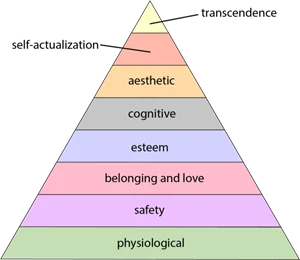Maslow's Hierarchy of Needs is a psychological theory proposed by Abraham Maslow in the 1940s. The theory suggests that individuals have a hierarchy of needs that must be fulfilled to realize one's full potential. Exam writers lean on it sometimes because of its simplicity--you either know it or you don't. So...know it! There's a practice question at the end of this post to see if you do.
The hierarchy is usually depicted as a pyramid with five levels:
- Physiological Needs: The most basic needs for survival, including air, water, food, sleep, and shelter. These needs must be met before an individual can focus on higher-level needs.
- Safety Needs: Once physiological needs are satisfied, individuals seek safety and security. This includes personal safety, employment stability, health, and a safe living environment.
- Love and Belonging: Social needs emerge once safety is assured. Individuals desire love, affection, a sense of belonging, and meaningful relationships with family, friends, and community.
- Esteem Needs: Esteem needs encompass both self-esteem (feeling confident and capable) and the desire for recognition and respect from others. Fulfillment of these needs contributes to a positive self-image.
- Self-Actualization: At the pinnacle of the hierarchy is self-actualization. This level represents the realization of one's full potential, personal growth, and the pursuit of goals aligned with one's values and passions.
 Though it doesn’t appear on the popular Maslow pyramid, Maslow later introduced the concept of "self-transcendence," suggesting that individuals can achieve a higher level of fulfillment by focusing on helping others and contributing to the greater good.
Though it doesn’t appear on the popular Maslow pyramid, Maslow later introduced the concept of "self-transcendence," suggesting that individuals can achieve a higher level of fulfillment by focusing on helping others and contributing to the greater good.
Maslow's Hierarchy of Needs has been widely influential in various fields, including psychology, education, business, and social work. It provides a framework for understanding human motivations and needs, helping professionals tailor interventions and strategies to meet individuals' diverse requirements for well-being and personal growth.
Will this be on the ASWB? If so, it’s good news. This is simple material, easy to intuit your way through, with one exception: The distinction between "Love and Belonging" needs and "Esteem" needs can confuse. Let's take a closer look at the reasoning:
Love and Belonging Needs: This level involves the need for social connections, friendships, family bonds, and a sense of belonging to a community. It focuses on the emotional connections that individuals seek to fulfill their need for companionship and acceptance.
Esteem Needs: Esteem needs are about self-respect, confidence, and the desire for recognition and respect from others. These needs are more closely related to self-worth and the individual's perception of their own abilities and achievements. If the client's primary struggle was related to a lack of confidence, feelings of inadequacy, or a need for recognition from others, that's "Esteem" needs on the exam.
In real-world situations, it's not uncommon for different needs to interplay and overlap. Social workers often need to consider multiple aspects of the hierarchy when assessing and assisting clients. It's crucial to carefully analyze the specific context and behaviors presented in the scenario to determine which need is most relevant.
Got it? Here’s a practice question to try out your knowledge:
A social worker has a client who recently moved to a new city for a job opportunity. The client has been struggling to make friends and establish meaningful connections in the new environment. The client expresses feelings of loneliness and isolation, which have started to impact their self-esteem. According to Maslow's Hierarchy of Needs, which level of need is most relevant to the client's situation?
A) Physiological Needs
B) Esteem Needs
C) Love and Belonging
D) Safety Needs
What’s your answer? It’s not A or D, right? But which of the other two options is best?
The client's feelings of loneliness, isolation, and the need to establish connections point to the "Love and Belonging" level of Maslow's Hierarchy of Needs. This level emphasizes the importance of social relationships, companionship, and a sense of belonging to a community. Even though “self-esteem” is mentioned, the client's struggle to make friends and establish connections indicates that the “Love and Belonging” level of need is not adequately fulfilled. Addressing the client's need for social interaction and helping them build supportive relationships can contribute to their overall well-being and self-esteem.
You’re that much more ready to go pass the social work exam.
To really get ready, try SWTP full-length practice tests.

 Though it doesn’t appear on the popular Maslow pyramid, Maslow later introduced the concept of "self-transcendence," suggesting that individuals can achieve a higher level of fulfillment by focusing on helping others and contributing to the greater good.
Though it doesn’t appear on the popular Maslow pyramid, Maslow later introduced the concept of "self-transcendence," suggesting that individuals can achieve a higher level of fulfillment by focusing on helping others and contributing to the greater good.